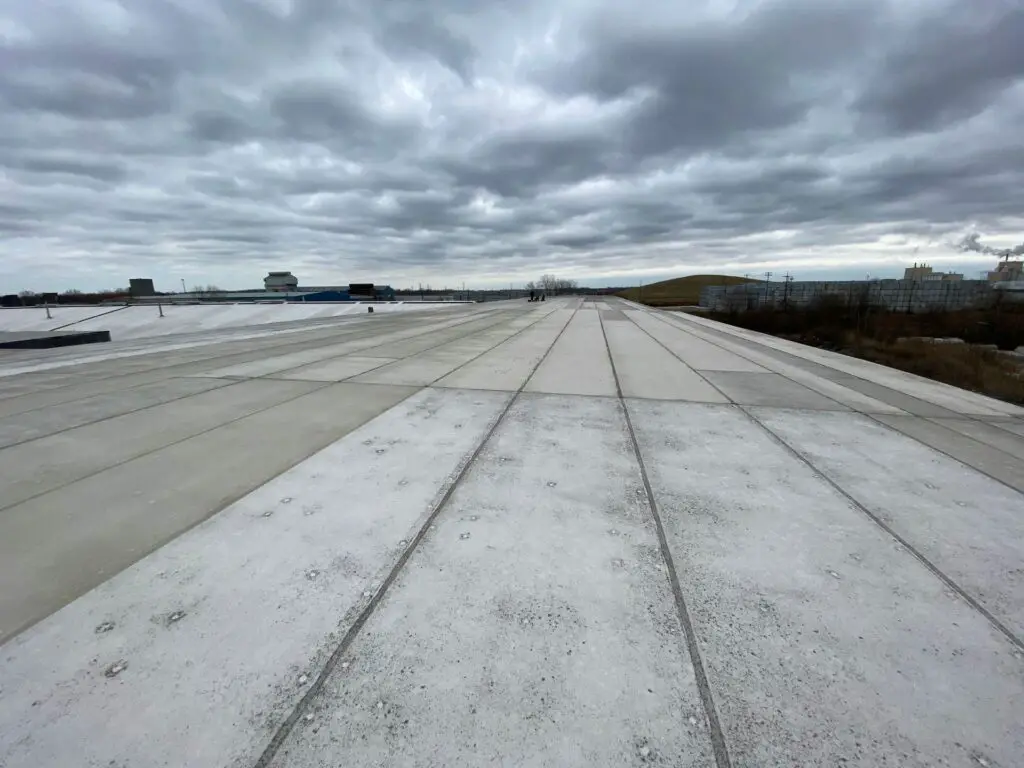Hypalon (CSPE) Roofing • Introduction to Hypalon
By Jack Gray, Roof Online Editor • Last updated February 14, 2023

Overview of Hypalon Roofing
Hypalon is a type of flat (low-slope) roofing material. It’s a single-ply roofing membrane material made out of a type of synthetic rubber known as chlorosulfonated polyethylene (CSPE). It is known for its durability, heat resistance, and resistance to UV light, chemicals, and weathering.
Hypalon was originally developed by DuPont in the 1950s and was used as a substitute for natural rubber, which was becoming scarce and expensive. It began to be used for roofing membranes in the mid 1960s, as a cheaper alternative to the labor-intensive built-up roofs which were prevalent at the time.
Although it never achieved the popularity of EPDM roofing, its main competitor in the single-ply roofing niche during the 70’s and 80’s, it did gain a respectable market share, and was considered an excellent low-slope roofing option for around 40 years.
Freshly-manufactured CSPE is a thermoplastic material. When a Hypalon roof is installed, the membrane sheets are typically heat-welded together, the same way that PVC or TPO roofing is.
An interesting fact about Hypalon roofing is that the material is somewhat unique in that it is thermoplastic when new (and being installed) but it loses this quality over time, and eventually becomes a thermoset material. This process takes around 5 years. After this period, the roof can no longer be repaired by heat-welding patches onto the roof; repair materials need to be applied using adhesives.
Some of the key benefits of Hypalon roofing include its exceptional chemical resistance, its ability to withstand extreme temperatures, its fire resistance, and its flexibility, which allows it to move and expand with the building structure. Additionally, Hypalon roofing is also known for its high tensile strength and elongation, which helps to prevent cracking and tearing over time.
One of the things that made Hypalon roofing attractive was the fact that it was typically produced as a white, reflective membrane, and could be considered a “cool”, energy-saving roofing material.
For a long time, its only competition in the market for cool roof membranes was PVC or white EPDM. And white EPDM wasn’t much of a competitor due to early problems related to the premature degradation of the white EPDM top layer of the membrane. White EPDM was also more expensive.
The introduction of TPO roofing in the 1990’s changed that. The market for Hypalon roofing was essentially crushed by the rise of TPO over the two decades after its introduction.
The production of Hypalon roofing membranes was discontinued by its manufacturer, DuPont, in 2010, and no new Hypalon roofs are being installed these days. There are manufacturers in Asia that currently produce CSPE material for various applications, but field membrane for commercial roof systems isn’t one of those applications.
However, there are still many existing Hypalon roofs in place on many different types of buildings around the US, and it’s certainly possible for you to encounter one. Well-put-together Hypalon roofs that were installed in the 2000s may last until the 2030s.
Related Articles
External Sources & References for Hypalon (CSPE) Roofing Information
1. General: See “Hypalon: Hype About Discontinuing“, an informative explanation of what Hypalon is, where it comes from, and why it’s hard to find these days. On the website of Wesco International.
2. General: “DuPont’s Exit of Hypalon Market Affects Geosynthetics” discusses DuPont’s decision to stop producing Hypalon and provides general details about Hypalon. On the Geosynthetica website.
3. General: A good short article, “Where Is Hypalon Among Today’s Roofing Options?” by the venerable roof expert Dick Fricklas, is archived on the Buildings.com website. The article is from 2010. (Update October 2022: It looks like they’ve cut off most of the article on that web page. We’ll leave the link up in case they fix it.)
4. Building Codes: “R905.13 Thermoplastic Single-Ply Roofing” from the 2018 International Residential Code and “1507.13 Thermoplastic Single-Ply Roofing” from the 2018 International Building Code. Both available on the UpCodes website.
5. Chemical Compatibility of Hypalon: See this chart for a long list of chemicals and whether you can expect them to damage Hypalon. Chart is made available by Mykin Inc.
6. Technical: A Hypalon roof membrane product specification. Viewable at Burke Industries’ website as a PDF document.
7. Technical: Data sheets for various now-discontinued Dupont Hypalon products are available at the MatWeb site.